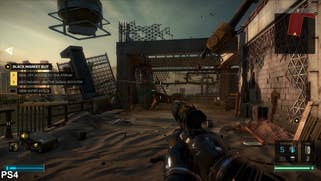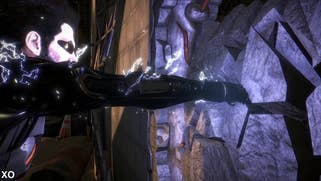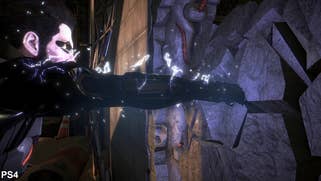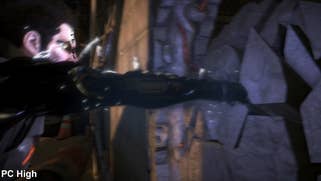Performance Analysis: Deus Ex: Mankind Divided
Initial console and PC comparisons from Digital Foundry.
Deus Ex: Mankind Divided is now available and we've now spent a good few hours with all three versions of the game. Powered by the Dawn Engine - an upgraded engine based on IO Interactive's Glacier 2 technology platform - this new title takes on a new look with plenty of advanced graphics features on display. The question is, how is it running thus far across the three platforms and which version should you play? Let's take a closer look.
Right out of the gate, we're looking at native 1080p on PlayStation 4 and 900p on Xbox One. Both versions employ a high quality temporal anti-aliasing solution that helps clean up edges, but this is somewhat spoiled by an aggressive, non-defeatable sharpening effect that produces visible edge ringing across the image. The PC version allows users to disable these options independently, in addition to taking advantage of the more demanding MSAA, though its impact on memory consumption - and indeed performance - is high.
In judging the technical performance of a game like this, there are a few key elements to consider including map size, loading times, and frame-rate. In this case, the Dawn Engine is capable of much larger maps than the previous Deus Ex, with a huge number of fully explorable buildings that can be entered without any additional loading. It's the first time since the original Deus Ex that we've seen maps of this scale and, in many ways, Mankind Divided is able to exceed that. The maps are simply huge and richly detailed throughout the game.
That's not to say there aren't occasional loading screens - you will run into them in certain instances and each platform produces varying results. Typically, loading kicks in when entering a new area for the first time, traveling between key hubs via the subway, or upon death. In terms of startup time, the PC version actually seems to require the most amount of time - even when running from an SSD with copious amounts of memory. Once the game loads the area, all subsequent loading times, including those upon death, are dramatically faster - requiring just a few seconds. This makes the PC version the fastest experience overall across the run of play.
Initial load times for each area are actually shorter on console, though they can vary in length depending on the size of the map - but unlike the PC version, they are not significantly reduced upon death. So for example, moving into a mission area sees loading times at less than 20 seconds on PlayStation 4, while Xbox One is around 10 seconds longer. The issue here is that, upon death, you need to wait just as long in order to retry - which can make trial and error frustrating in certain situations.
Then we have performance. Both consoles target 30fps and generally manage to deliver this, but there are trouble spots throughout the game. Each of the main areas within Prague tend to impact frame-rate while simply moving around the world - a problem possibly tied to asset streaming as these problems can clear up once data is finished loading. The game uses an adaptive v-sync solution, resulting in screen-tear along the top portion of the image when either game drops below its target. This occurs more frequently on Xbox One, particularly during the introduction sequence within the train station, but can become an issue on both platforms. Thankfully, it's not something that crops up regularly during missions but it makes hub exploration feel less polished.
The PC version certainly proves interesting based on our first impressions. There is a massive gulf in performance between the lowest and highest settings with ultra averaging around 33 frames per second on a GTX 970 when using the in-game benchmark at 1080p. Thankfully, the game itself does run quicker than this during normal gameplaym and a mix of high and medium settings were enough to reach 60 frames per second. The lower settings also have little issue reaching higher frame-rates so the PC version of Deus Ex should be scalable across a wide range of machines. For those looking to reach 4K, it may be necessary to cap the frame-rate at 30fps in order to reach any sort of consistency.












The increase in performance in certainly a great benefit for the PC version, but it's the ability to adjust various settings independently that helps most here. The sharpening filter, which we're not too keen on, can be disabled here and the resulting image is much more attractive. Some of the additional visual features on display are also nice - per-object motion blur is exclusive to the PC version, as are contact hardened shadows. This ability to tweak the game can result in a much improved overall presentation across the board.
That said, some users have complained about mouse acceleration and overly sensitive default settings. It's hard to ascertain where the problem lies specifically, but there's certainly something going on with the mouse input in the game which requires tweaking to reach a palatable state. We also noticed issues with the HUD - it's possible to disable all HUD elements for screenshot purposes but certain pop-ups are impossible to remove making this more frustrating than it should be.
Ultimately, though, Deus Ex: Mankind Divided is looking to be a great game no matter where you play it. The PC version offers the smoothest possible experience provided you have the hardware to handle it, but the console versions are still very good. Of the two, the PlayStation 4 version has an advantage with a smoother frame-rate, a higher resolution and shorter loading times. We'll know more as we finish testing the game this week. In the next few days, look out for a more detailed look at the graphical features available in the game and how the various PC settings stack up.










